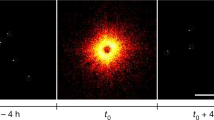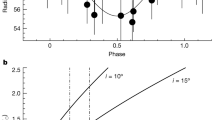Abstract
The classical nova outburst is caused by a thermonuclear explosion on the surface of a white dwarf1,2. The explosion ignites at the base of an envelope of hydrogen-rich material which has been accreted from a binary companion star. It has long been evident, however, that in the explosion most of the envelope is not consumed by nuclear burning, but is ejected from the system. This is because to consume the envelope mass (~ 10−4 M⊙) at the maximum possible rate (with luminosity equal to the Eddington limit) would take ~300 years, whereas classical novae return to their pre-outburst brightness within ~10 years (ref. 3). Rough confirmation of this is given by the fact that the masses of shells of material observed to be ejected from novae are in the range 10−3 to 10−5 M⊙ (ref. 4). Here we consider the effect on the orbital parameters of a classical nova of the ejection of mass during the nova explosion. The most easily observable consequence is the generation of a small eccentricity in the orbit which leads to a luminosity modulation at a period just longer than the orbital period. Observation of such an effect, would have implications not just for interpreting the dynamics of the explosion but also for measuring the secular effect of tidal interaction after the outburst.
This is a preview of subscription content, access via your institution
Access options
Subscribe to this journal
Receive 51 print issues and online access
$199.00 per year
only $3.90 per issue
Buy this article
- Purchase on SpringerLink
- Instant access to full article PDF
Prices may be subject to local taxes which are calculated during checkout
Similar content being viewed by others
References
1. Gallagher, J. S. & Starrfield, S. A Rev. Astr. Astrophys. 16, 171–214 (1978). 2. Truran, J. W. in Essays in Nuclear Astrophysics (ed. Barnes, C.) 467–495 (Cambridge University Press, 1985). 3. MacDonald, J., Fugimoto, M. Y. & Truran, J. W. Astrophys. J. 294, 263–270 (1985). 4. McLaughlin, D. B. in Stars and Stellar Systems Vol. VI, (ed. Greenstein, J. L.) 585–653 (University of Chicago Press, 1960). 5. Starrfield, S., Truran, J. W. & Sparks, W. M. Astrophys. J. 226, 186–202 (1978). 6. Bath, G. T. & Shaviv, G. Mon. Not. R. astr. Soc. 175, 305–322 (1976). 7. MacDonald, J. Mon. Not. R. astr. Soc. 191, 933–949 (1980). 8. Paczynski, B. & Sienkiewicz, R. Acta. astr. 22, 73–92 (1972). 9. Edwards, D. A. & Pringle, J. E. Mon. Not. R astr. Soc. (in the press). 10. Pringle, J. E. & Wade, R. A. (eds) Interacting Binary Stars (Cambridge University Press, 1985). 11. Shara, M. M., Livio, M., Moffatt, A. F. J. & Orio, M. Astrophys. J. (in the press). 12. Robinson, E. L. Astr. J. 80, 515–524 (1975). 13. Savedoff, M. P. & Vila, S. Astr. J. 69, 242–245 (1964). 14. Papaloizou, J. C. B. & Pringle, J. E. Mon. Not. R astr. Soc. 189, 293–297 (1979). 15. Campbell, C. G. & Papaloizou, J. C. B. Mon. Not. R. astr. Soc. 204, 433–447 (1983).
Author information
Authors and Affiliations
Rights and permissions
About this article
Cite this article
Edwards, D., Pringle, J. Orbital eccentricity in classical novae. Nature 328, 505 (1987). https://doi.org/10.1038/328505a0
Received:
Accepted:
Issue date:
DOI: https://doi.org/10.1038/328505a0



